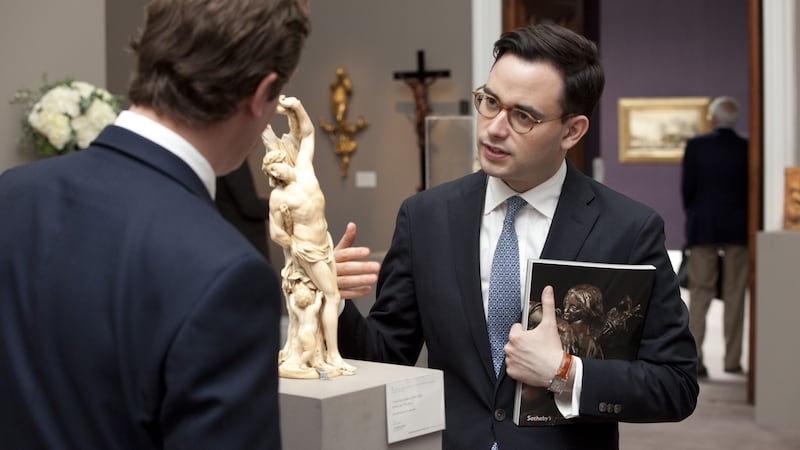Buying the work of a young, up-and-coming artist could prove to be a good long-term investment but picking a winner is like predicting the Grand National or spotting the penny-stock destined to become a blue-chip share. The blunt truth is: most art is never to going to become really valuable.
There are some very notable exceptions. Among the most dramatic examples, people who bought art made by Francis Bacon in London for a few hundred pounds in the 1960s, or by Jean-Michel Basquiat in New York for a few thousand dollars in the early 1980s, have seen prices for their paintings jump and now routinely sell for tens of millions of pounds or dollars each.
But these are among the Lotto-style exceptions. In Ireland only one painting has ever achieved a seven-figure sum at auction when in 2011 a Jack B Yeats oil-on-canvas, A Fair Day, Mayo, sold for €1 million at Adam's saleroom in Dublin.
To put that into an international context, the highest price ever paid for any work of art sold at auction was achieved in 2015 when a painting by Picasso, Les Femmes D'Alger (Version "O") – known in English as The Women of Algiers – made $179.4 million at Christie's, New York.
The art market is quite like the stock market. Prices can – and do – fall as well as rise sharply. Art has no intrinsic monetary value – and the price of a painting or sculpture is simply what someone is prepared to pay on a particular day.
Tastes change, and in the Irish art market there are only a handful of artists whose work consistently makes big money decade after decade and who would be considered “safe” from an investment perspective – among them: Jack B Yeats, Paul Henry, Sir John Lavery and Sir William Orpen.
Here’s some advice from the experts on what to look out for and what not to buy.
Rory Guthrie, director at de Veres art auctioneers
“Never buy a poor work based solely on an artist’s reputation or fame. A bad picture is always going to be a difficult seller in any market – no matter who painted it – whereas a piece of quality will always find a buyer.
Presentation is hugely important. The right framing and a good clean can make a big difference, while a good restorer can bring a painting back to life. Making this extra investment, when required, can pay big dividends in the sale room.
To know a piece of art you have to see it in the flesh, to touch it, even smell it! The back of a painting can often tell you more than the front, and nine times out of 10 your first instinct about a picture is the right one. So don’t be afraid to ask to take a painting off the wall and hold it in your hands. You should get to know your painting as well as you can before you buy it.”
Adelle Hughes, associate director at Whyte’s Auctioneers
“Cultivate your taste, make considered choices but trust your instinct, and if you need professional advice don’t be afraid to ask. When thinking about buying a painting ask: ‘Is it a good example by the artist? What is the condition? Will I need to spend money getting it reframed? Where will it hang?’ Investors should think long-term. Buy the best you can afford instead of mediocre examples by several artists.”
Morgan O’Driscoll, art auctioneer, Skibbereen, Co Cork
“If you are buying for investment, beware the lure of the “sell-out” exhibition – it’s no guarantee for the future and trends and fashions are fickle. If you are building a collection keep an eye on auction results which are an excellent guide as to whether it’s a good or bad time to buy or sell a particular artist. I think that contemporary Irish art is undervalued at the moment – artists like Louis le Brocquy, John Shinnors and Tony O’Malley. Their prices went up during the boom and then down – with a bang – afterwards.”
James Gorry, picture restorer and art dealer, The Gorry Gallery
“I believe in the traditional aesthetic of collecting, rather than investing, and encourage collectors to buy paintings which give them pleasure. Real quality stands the test of time and endures beyond changing trends in taste. Painting is a craft, the brush work should be studied carefully, learning to recognise the hand of the artist without relying on a signature.

Good condition is essential, and the original frame desirable. Social and political injustice in 19th century Ireland was seldom portrayed by native painters but mostly by visiting artists such as the American, Howard Helmick and the Scot Erskine Nicol. Their paintings of traditional Irish rural interiors – a record of the life and customs of our ancestors – can still be bought for a fraction of the cost of a minor Paul Henry painting. Topographical views – an invaluable part of our heritage – are also always sought after regardless of who painted them, and can often be acquired for very modest sums. “
Penny Day, head of Irish art and director of modern British art, Bonhams
“It’s always wise to buy the very best example of what you can afford; one good picture is worth 10 average ones. The “big names” like Jack Yeats and Paul Henry are still holding their value well, and will likely carry on doing so in my opinion. At the more modern end of the spectrum, though, I wouldn’t be surprised to see prices for Patrick Scott continue to increase as his work becomes more internationally recognised. And try not to always sit in front of a computer browsing galleries and salerooms, get out there and stand in front of things. There’s no better way to learn to recognise quality (or lack thereof!) than by looking at as much as possible in person.”
Charlie Minter, head of Irish art, Sotheby’s, London
“There’s no place quite like the auction world; buying art involves an emotional and financial commitment – it’s rarely one without the other. I think it’s therefore important to buy what you like, but also to know what you’re buying. Is it a good example by the artist? Is it sensibly priced? How is the market performing? I would advise attending auctions, visiting galleries, speaking to experts and discovering what you do and don’t like. The more you explore the subject, the more you are likely to gain from it, and there’s really nothing quite like the joy of owning your own piece of art. The Irish art market is currently at an interesting place. There is a definite sense confidence is returning to the market, so I think right now there are opportunities to be had.”
David Britton, director at Adam’s
“Read about your area of interest before starting to collect – there are now more reference books than ever. Try to view as much art as possible to see what pictures or sculptures you like. The quality of exhibitions being put on by the art galleries throughout Ireland is superb and admission is generally free. In addition to the National Gallery of Ireland, other recommended venues include the Crawford in Cork, the Model Arts in Sligo, The Highlanes in Drogheda and the FE Mc William Gallery in Banbridge – which all put on excellent exhibitions. Sign up with auctioneers to receive catalogues or view them free online, and attend pre-auction viewings which show a great cross-sections of art from all periods and at all price levels.”
Christopher Mason, specialist in European sculpture, Sotheby’s
“My principal specialism is marble sculpture. The key thing to look for are marbles with their original surfaces. A marble with its intended surface, which has not been lost due to weathering or overcleaning, is likely to retain its value.

The Irish neoclassical sculptor John Hogan (1800-1858) was renowned for his beautiful polished surfaces, and his most famous works include the Dead Christ at St Teresa's Church in Clarendon Street, Dublin. It would be a great find if one were to come across one of his marbles in good condition."
Bill Canning, director of Kilkenny Fine Art
Contemporary art is the “emperor’s new clothes” – many of the paintings are abstract and don’t tell a story. At present Victorian art is undervalued because it has been out of fashion since the 1990s. But I’m confident it will come back into fashion and that prices will rise. That’s because Victorian art has stood the test of time – the artists had great skill and could tell a story. Victorian art is generally valued on the basis of three criteria – the subject, the quality of the picture and, importantly, the frame. If any one of those three is of poor quality then don’t buy. Sometimes you can find a beautiful, well-painted picture in a terrible frame, and even though you might be tempted don’t be!
John de Vere White, Veres art auctioneers
“You must be enthusiastic and be prepared to do the ground work. I always advise: quality rather than quantity. Buyers whose sole interest is in investment invariably come a cropper. Among artists worth considering is Hughie O’Donoghue – the English artist is one of the most serious painters working in Ireland today. Irish painters who were once coveted like Louis le Brocquy and Tony O’Malley – whose prices fell during the economic crash – are major names and are seriously undervalued.”
Patrick Meade, deputy chairman of Bonhams
“Once you start on the road to collect never sell the first work you buy. It will always be a reminder of ‘how it all started for you’. Get advice, and use the myriad tools available – including the internet – to research works.

Don’t be afraid to make mistakes, because you will. Buy the best work of a lesser artist than the worst work of a great artist. But don’t buy anything simply because it is cheap, and buy the best examples you can in any given category. Don’t buy “names” just because everyone else is buying them. Dare to be different. Contemporary art is flavour of the month now but there are world -class works available by artists that sell for less than they did 20 years ago. If you like these categories, don’t be put off by present trends. That’s why they are called trends, because they change. “












